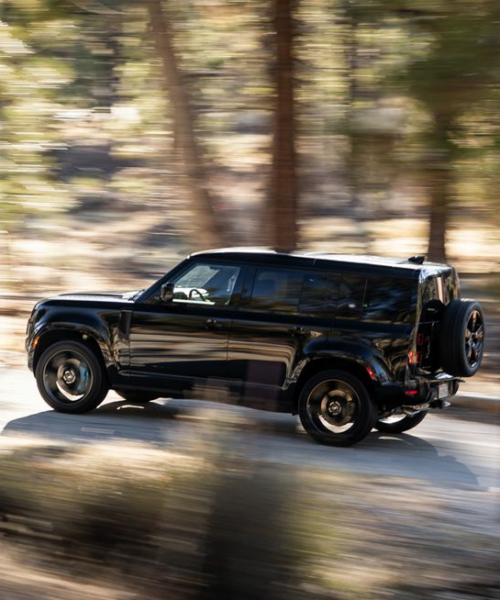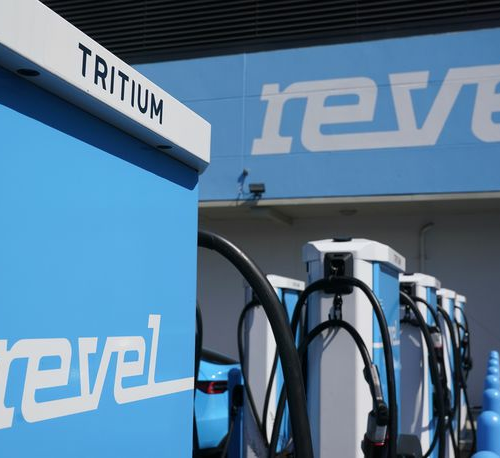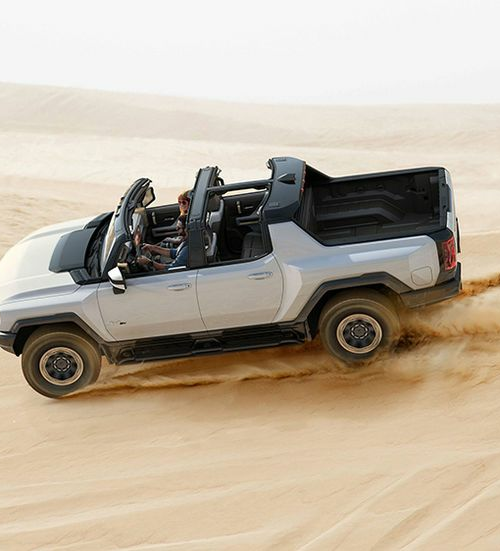BY K.C. COLWELL | CarAndDriver.Com
Troy Warren for CNT #Cars
The first electric pickup of the modern era proves to be a practical workhorse and an impressive bit of electric-vehicle technology.
From the February/March issue of Car and Driver.
“Cool truck, bro. Is that the Cybertruck?” asked a curious holiday shopper. We were on our first nighttime excursion in the Rivian R1T. Its unique light signature gives it away as something different in the pickup-rich environment of southeastern Michigan. It’s possible the shopper had a sense of humor and was riffing off comments from former Rivian executive Laura Schwab, who skewered Rivian for having a “toxic bro culture” and filed a gender-discrimination lawsuit against the marque days before the company went public. Well, as the opening stock price attests, Rivian is indeed a tech-bro fave. Three days after the IPO, the 12-year-old company’s value surpassed $120 billion. At press time, its value had dropped to $71 billion.
Whatever the company’s value, it turns out that Rivian makes one hell of a little truck. We say “little” because while the R1T Launch Edition’s base price of $74,075 is anything but, its dimensions and proportions are closer to those of a mid-size pickup. To the eye, it seemed identical in size to our photographer’s Ford Ranger. Yet at 217.1 inches long, the R1T is 6.3 inches longer and its wheelbase of 135.8 inches a whopping 9.0 inches longer.
By mass, the R1T’s 7173 pounds is closer to that of the heavy-duty, three-quarter-ton full-size pickup class. Much of its weight is attributable to the 7776 cells in the 1755-pound, 128.9-kWh battery pack [see “Curiosities” to learn where one more cell lives]. No traditional heavy-duty pickup, however, has 835 horsepower at its disposal. That power makes the R1T the quickest pickup we’ve ever tested. Sixty mph comes in 3.3 seconds; 100 arrives in 9.0. A quarter-mile pass takes 11.9 seconds with the truck going 110 mph. The four electric motors each drive a wheel, and launches are easy and repeatable. A motor at every corner can enable a Tank Turn feature that does a skid-steer impression, but that’s not in production yet.
HIGHS: Scorching acceleration, composed ride, upscale environs.
The motors also provide enough regen to allow for one-pedal operation. Even in Standard regen mode (High is available, too), there is no need to step into the soggy and soft brake pedal and activate the four-wheel discs. Take a Rivian to a driver’s test and you won’t have to touch the brake pedal unless someone cuts you off. Should you need to hit the brakes hard, the truck stops from 70 mph in 177 feet. That’s an impressively short distance given this thing’s weight and our test truck’s 20-inch rugged Pirelli Scorpion All Terrain Elect tires (developed specifically for Rivian). The Pirellis are a no-cost option over the more street-friendly 21-inch all-seasons.

The Rivian puts down strong straight-line performance, as you probably could have guessed. We’ve come to expect wicked acceleration from electrics. What makes this truck great is how well it drives. Thanks to an independent suspension, front and rear, fitted with adaptive dampers, air springs, and hydraulic anti-roll control—McLaren road cars use the same tech, which is banned in most motorsports—this 3.5-ton truck rides like a luxury sedan. Even set to Stiff, the suspension is only about as unforgiving as a normal pickup’s. Should you need more ground clearance, the air springs offer 6.5 inches of vertical adjustment. Only when attempting to hustle the R1T down a country road or on a skidpad, where its Pirellis delivered 0.80 g, do you feel its mass and inertia resisting the steering wheel’s commands.
One of our biggest questions, and likely yours, too, is how far an electric pickup truck packing one of the biggest batteries currently on sale can travel on a charge. The EPA says to expect a range of 314 miles, but that’s with the highway tires, not the all-terrain rubber. In our 75-mph highway test, we found the R1T’s range to be 220 miles. Hook up a trailer and the range is halved [see our towing test]. Our observed efficiency, 35 MPGe, was half the EPA’s combined estimate of 70 MPGe. Some of this low score is attributable to the off-road-ready Pirellis; some may be due to near-freezing ambient temperatures. To see how the cold affected the battery, we’ll have to get an R1T back to test in a more temperate season. (It’s worth noting that this battery is the R1T’s medium offering. A larger battery with an estimated 172.0-kWh capacity will reach customers in 2023 and be followed by a smaller pack of undisclosed size.)
The R1T’s nearly all-black interior is sophisticated yet inviting. Rivian wraps the seats in “vegan leather” [see “Impossible Leather,”], marketing’s way of saying “vinyl.” Fortunately, all the surfaces, including open-pore wood accented by not-too-bright ambient lighting, look and feel commensurate with our R1T Launch Edition’s $76,875 price. The back seat is roomy, but not Ram 1500 spacious. The bed, frunk, and gear tunnel—a cargo area spanning the width of the truck behind the rear doors—combine for 52 cubic feet of lockable storage.

LOWS: Range falls short of EPA estimates, overreliance on touchscreen, electronic gremlins.
Rivian’s interfaces and controls are right out of Tesla’s playbook. Adjusting the rake and reach of the steering wheel, the position of the side mirrors, and even the angle of the HVAC vents is done through the central 16.0-inch touchscreen. The 12.3-inch instrument cluster also mimics a Tesla, giving you a real-time situational report that kinda looks like a modern version of the rolling road in the ’80s arcade game Pole Position, with virtual cars and trucks passing by a stationary R1T image. Even the R1T’s adaptive cruise control and Driver+ (Rivian’s semi-autonomous system) are activated just as they would be in a Tesla, by tapping the gear stalk.
Fortunately, Rivian didn’t copy Tesla’s cabin sound levels. At a steady 70 mph, the R1T’s interior hums at 67 decibels, which is three lower than our long-term Model 3. Unlike in the Tesla, here the driver is more isolated from the sounds made by bumps, expansion joints, and rough pavement. Credit the R1T’s thick layer of comfort and refinement to its mass and “skateboard” architecture, the combination of battery pack and body-on-frame structure low in the truck.
We had an R1T running early software that Rivian blamed for our biggest complaint: numerous infotainment-screen crashes. We couldn’t discern any reason why, but on occasion the screen would go black. Once, the instrument display and the center screen suffered simultaneous strokes, which could have allowed us the rare opportunity to tell an inquisitive officer that we honestly didn’t know how fast we were going. The screens always returned to life when we parked the truck and, for lack of a better term, cycled the ignition, by exiting and locking the door since there’s no on/off button. Rivian tells us that an over-the-air update should address the issue.

VERDICT: A hugely impressive and fun-to-drive electric pickup, right out of the box.
Reliability is a legitimate concern with any new product or company. And getting a Rivian fixed might be a challenge in the short term, too. Service centers are in major hubs—New York City, L.A., Denver—with plans to have 120 brick-and-mortar service shops and more than 1000 service vans running in 2023. Tesla went through these same growing pains, and Rivian’s teething problems may eventually be solved when service centers reach critical mass. If Rivian takes good care of its early adopters, we believe that the brand will enjoy the same sort of evangelical devotees that Tesla does.
Among former Rivian exec Schwab’s concerns was that Rivian prices its vehicles too low and takes too much of a loss on each unit. That may be, but bold pricing can build volume and convince customers that their R1T is a good buy, minor annoyances or not. We expect they’ll feel the same way we do: that the R1T is an incredibly cool truck.
Dialogue
Charmed by diesel-truck torque and the clattery heartbeat of heavy equipment? Well, the Rivian R1T has serious torque, but it only whispers. Flooring one doesn’t make much more of a whir than parking one, but from a stop, 60 mph is yours in 3.3 seconds—about as much time as it takes to turn a diesel-torque disciple into an electric-torque convert. Who cares that the only sound you’ll hear on your way to 60 is your neck snapping backward? —Austin Irwin, Associate Editor
While I’m excited about the R1T’s quick acceleration, luxurious ride quality, and numerous clever features, our early-build test truck had a litany of issues that need to be addressed before buyers take delivery. While some (not us) might overlook the occasional misaligned body panel or a spare-tire cover that requires far too much effort to shut, everyone will be frustrated by the touchscreen. With its frequent crashes and often lethargic reactions to inputs, the screen is one area that Rivian desperately needs to fix. —Carlos Lago, Deputy Editor, Video
Specifications
2022 Rivian R1T Launch Edition
Vehicle Type: front- and rear-motor, all-wheel-drive, 5-passenger, 4-door pickup
PRICE
Base/As Tested: $74,075/$76,875
Options: Off-Road upgrade, $2000; full-size spare tire, $800
POWERTRAIN
4 permanent-magnet synchronous AC motors
Combined Power: 835 hp
Combined Torque: 908 lb-ft
Battery Pack: liquid-cooled lithium-ion, 128.9 kWh
Onboard Charger: 11.5 kW
Transmissions: direct-drive
CHASSIS
Suspension, F/R: control arms/multilink
Brakes, F/R: 13.5-in vented disc/12.9-in vented disc
Tires: Pirelli Scorpion All Terrain Elect
275/65R-20 116H M+S 3PMSF RIV
DIMENSIONS
Wheelbase: 135.8 in
Length: 217.1 in
Width: 79.3 in
Height: 73.0 in
Passenger Volume: 107 ft3
Cargo Volume: 37 ft3
Curb Weight: 7173 lb
C/D TEST RESULTS
60 mph: 3.3 sec
100 mph: 9.0 sec
1/4-Mile: 11.9 sec @ 110 mph
Results above omit 1-ft rollout of 0.2 sec.
Rolling Start, 5–60 mph: 3.4 sec
Top Gear, 30–50 mph: 1.7 sec
Top Gear, 50–70 mph: 2.1 sec
Top Speed (gov ltd): 111 mph
Braking, 70–0 mph: 177 ft
Roadholding, 300-ft Skidpad: 0.80 g
C/D FUEL ECONOMY
Observed: 35 MPGe
Highway Range: 220 mi
EPA FUEL ECONOMY
Combined/City/Highway: 70/744/66 MPGe
Range: 314 mi


































